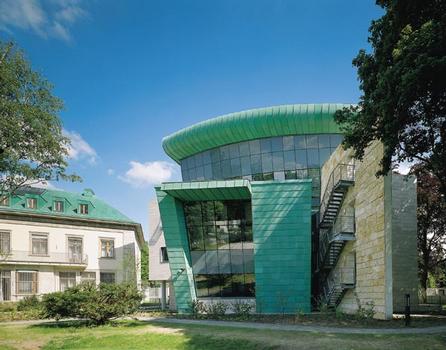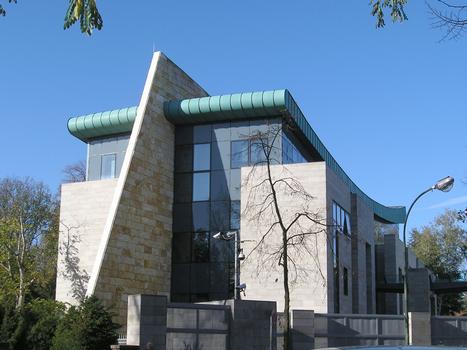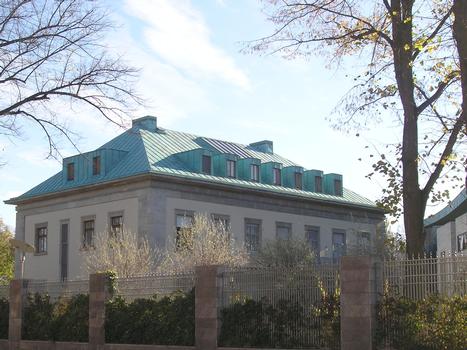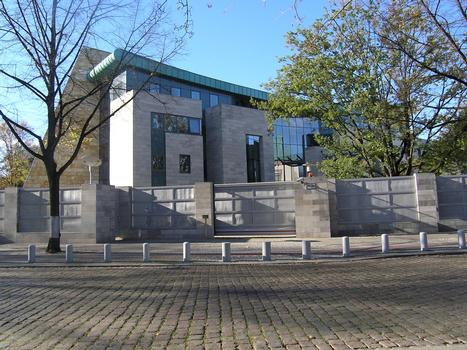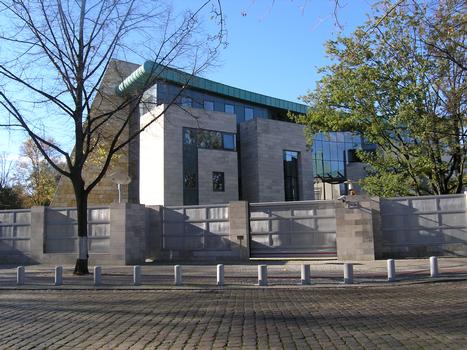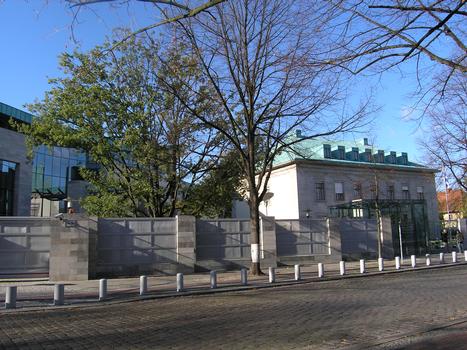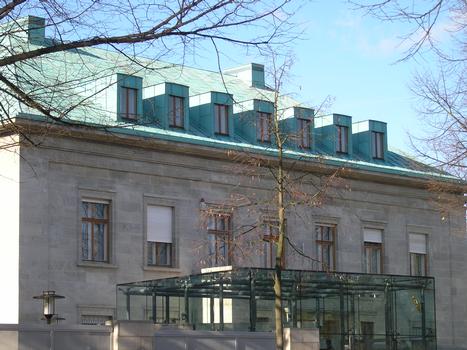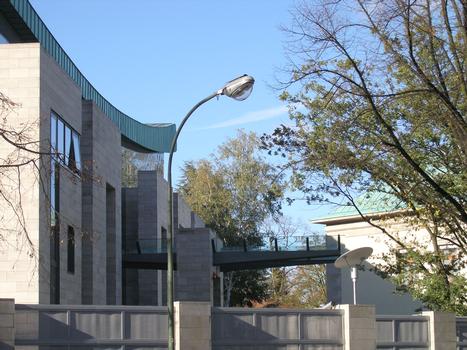General Information
| Completion: | 9 May 2001 |
|---|---|
| Status: | in use |
Project Type
| Function / usage: |
Embassy |
|---|
Location
| Location: |
Berlin-Schmargendorf, Charlottenburg-Wilmersdorf, Berlin, Germany |
|---|---|
| Address: | Auguste-Viktoria-Straße 74-78 |
| Coordinates: | 52° 29' 0.35" N 13° 17' 19.06" E |
Technical Information
Dimensions
| area of the building lot | 8 967 m² |
Case Studies and Applied Products
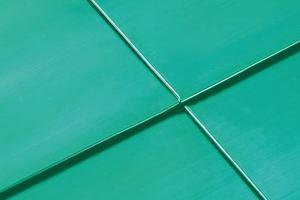
TECU® Patina
Using a specially developed industrial process, TECU® copper sheets are patinated green on one side.
[more]Notes
In an inaugural ceremony on May 9th, 2001, the first Israeli embassy in Berlin was officially opened. Located in Grunewald, a part of town set aside from Berlin's diplomatic and governmental quarters, the state of Israel presents itself in a new, functional embassy building constructed in Israeli style and designed by the Israeli architect Orit Willenberg-Giladi. The Jewish Councillor of Commerce, Herrmann Schöndorff, had erected a grand bourgeois villa in the 1930s at this historical spot on the Auguste-Victoria-Strasse 74-78, and the building is now, after extensive renovations, used for official receptions and as the ambassador's accommodation. Nestled in a park and shaded by old trees, the old original building together with the newly built, sculptural office building make up the Israeli embassy ensemble in Berlin.
The ensemble's architect, Orit Willenberg-Giladi, was born in Israel in 1960. Her parents were of Polish decent, survivors of the Holocaust in Europe. Since her degree in architecture, which she received "cum laude" from the University of Haifa in 1985, she has been working as a freelance architect in Tel Aviv. Among Orit Willenberg-Giladi's most important works are the Israeli Embassy buildings in Bangkok, Manila and Geneva. A school project for the Arabian village of Abu Gosh will also soon be on display in Germany as part of the exhibition "Encounters - the paradox of native Israeli architecture".
Architects of Willenberg-Giladi's generation have been shaped by both the overwhelming influence of modern design - many students of the Bauhaus period emigrated to Israel and actively participated in the building of cities - and by post-modern styles from the USA. A functionalist architectural language developed from these influences that has been combined with a certain heroic, national pathos, defining a style of architecture that is uniquely Israeli.
Though she had already proved herself in three previous embassy projects, her own, very personal family history made the invitation to take part in the architectural contest in 1998 anything but routine for Orit Willberg-Giladi. The Israeli Foreign Ministry's goal was to create an embassy building that embodied the complexity and symbolism associated with the representation of a Jewish state in a reunited Berlin.
The contractors found the appropriate estate for their embassy in Grunewald, a part of the city that was mainly home to German-Jewish middle and upper middle class residents before the war. In contrast to the area around the Oranienburger Strasse in Berlin-Mitte, where the life of the religious orthodox was led very publicly, life here was more secluded, with no apparent differences between Jewish and non-Jewish population. For this reason, Grunewald was not an area targeted by Nazi-activist propaganda; the Jewish people residing here quietly retreated into exile. Herrmann Schöndorff, a member of the Board of the Rudolf Karstadt AG, was only able to enjoy his villa on the Auguste-Victoria-Strasse for four years before he fled to Paris in 1934. The state of Israel chose this property to build the first Israeli embassy in Berlin.
Orit Willenberg-Giladi's idea was to convert Schöndorff's residence into a smaller version of a Baroque palace with a free-standing, new embassy building set to one side and integrated in the park grounds.
The front of the new office building is composed of six stone pylons that rise up before a continuous glass facade. The number six is in memory of the six million Jewish victims of the NS regime. The body of the building is pierced by an inner wall made of Israeli sandstone that follows one of the structure's central axes. The physical presence of warm yellow, unhewn wall running eastward up over the roof of the building brings a message of Israeli identity to Berlin.
The formal connection between the office and the original building is created through the selection of materials. The facades of both buildings are made of the same grey shelly limestone, but have been completed in different ways according to the building typology. The bold suspended roof of the new building and the hipped roof of the original house are clad in the lively green of pre-patinated brand-name TECU®-Patina copper sheets. Durable TECU® systems for roofs and facades have been proven in restoration projects with high technical and design demands as well as in the shaping of roofscapes and exterior cladding for modern architecture. The high degree of adaptability of TECU® products ensures that every detail can be finished to perfection. In contrast to a paint coating, the natural surface of TECU®-Patina remains active, reacting to the influences of weathering. It will harmonize well with other building materials for generations to come.
Between the new office building and the villa, which was remodeled to function as a reception hall and residence, a circular area marks the entrance area to both buildings. The welcoming gesture of the new building is symbolic: one of the six pillars is set apart from the facade, forming a gate that extends a welcoming hand out to the courtyard. A small vestibule, backed by a sandstone wall, forms the entrance hall. On the left is the consulate department, to the right the security gates to a protected area of the embassy. Three floors of offices are located above the main hall and staircase, which is also meant to be used for internal celebrations and events. The hall is dominated by a powerful, two-storey cube clad in TECU®-Patina - an independent body that pushes into the building from the north. Exposed here, but at the same time well protected, are the ambassadors' offices and the conference room. Pre-patinated TECU®-Patina copper sheets protect the cube's surface against wind and weather and add a pleasing color accent to the interior.
The original building was remodeled on the ground floor to create a spacious layout suitable for official receptions. The upper floor is the private residence of the ambassador.
The embassy ensemble warmly welcomes visitors with symbolic gestures and emphasizes Israel's openness to meeting the people of Germany. The fence encircling the estate has an upright saw-tooth profile with safety glass on every short side. The glass sections allow glimpses of the estate from the outside, displaying again the symbolic openness, just as the substantial use of glass for the new building does, that underlines the country's efforts to establish transparent communications in Germany.
In the eyes of the contractor, their new building is the most beautiful Israeli embassy that has ever been built. Israel has made its mark in Berlin with a building full of character that expresses its country's uniqueness and self-confidence.
Participants
Relevant Web Sites
- About this
data sheet - Structure-ID
20006957 - Published on:
29/11/2002 - Last updated on:
21/04/2016

